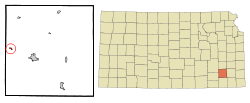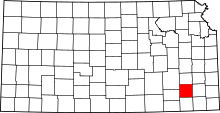New Albany, Kansas
| New Albany, Kansas | |
|---|---|
| City | |
 Location within Wilson County and Kansas | |
 KDOT map of Wilson County (legend) | |
| Coordinates: 37°34′4″N 95°56′22″W / 37.56778°N 95.93944°WCoordinates: 37°34′4″N 95°56′22″W / 37.56778°N 95.93944°W | |
| Country | United States |
| State | Kansas |
| County | Wilson |
| Area[1] | |
| • Total | 0.23 sq mi (0.60 km2) |
| • Land | 0.23 sq mi (0.60 km2) |
| • Water | 0 sq mi (0 km2) |
| Elevation | 892 ft (272 m) |
| Population (2010)[2] | |
| • Total | 56 |
| • Estimate (2012[3]) | 54 |
| • Density | 240/sq mi (93/km2) |
| Time zone | Central (CST) (UTC-6) |
| • Summer (DST) | CDT (UTC-5) |
| ZIP code | 66759 |
| Area code | 620 |
| FIPS code | 20-50150 [4] |
| GNIS feature ID | 0475073 [5] |
New Albany is a city in Wilson County, Kansas, United States. As of the 2010 census, the city population was 56.[6]
History
New Albany was founded in 1866.[7] It was named after New Albany, Indiana.[8]
The first post office in New Albany was established in May 1866.[9]
Geography
New Albany is located at 37°34′4″N 95°56′22″W / 37.56778°N 95.93944°W (37.567805, -95.939453).[10] According to the United States Census Bureau, the city has a total area of 0.23 square miles (0.60 km2), all of it land.[1]
Demographics
| Historical population | |||
|---|---|---|---|
| Census | Pop. | %± | |
| 1880 | 232 | — | |
| 1910 | 213 | — | |
| 1920 | 223 | 4.7% | |
| 1930 | 150 | −32.7% | |
| 1940 | 165 | 10.0% | |
| 1950 | 152 | −7.9% | |
| 1960 | 104 | −31.6% | |
| 1970 | 59 | −43.3% | |
| 1980 | 78 | 32.2% | |
| 1990 | 60 | −23.1% | |
| 2000 | 73 | 21.7% | |
| 2010 | 56 | −23.3% | |
| Est. 2015 | 53 | [11] | −5.4% |
| U.S. Decennial Census | |||
2010 census
As of the census[2] of 2010, there were 56 people, 23 households, and 17 families residing in the city. The population density was 243.5 inhabitants per square mile (94.0/km2). There were 32 housing units at an average density of 139.1 per square mile (53.7/km2). The racial makeup of the city was 96.4% White and 3.6% from two or more races. Hispanic or Latino of any race were 7.1% of the population.
There were 23 households of which 30.4% had children under the age of 18 living with them, 73.9% were married couples living together, and 26.1% were non-families. 26.1% of all households were made up of individuals and 13% had someone living alone who was 65 years of age or older. The average household size was 2.43 and the average family size was 2.94.
The median age in the city was 46.5 years. 23.2% of residents were under the age of 18; 1.8% were between the ages of 18 and 24; 21.4% were from 25 to 44; 32.2% were from 45 to 64; and 21.4% were 65 years of age or older. The gender makeup of the city was 55.4% male and 44.6% female.
2000 census
As of the census[4] of 2000, there were 73 people, 30 households, and 23 families residing in the city. The population density was 321.9 people per square mile (122.5/km²). There were 41 housing units at an average density of 180.8 per square mile (68.8/km²). The racial makeup of the city was 94.52% White, 4.11% Native American, and 1.37% from two or more races. Hispanic or Latino of any race were 1.37% of the population.
There were 30 households out of which 23.3% had children under the age of 18 living with them, 70.0% were married couples living together, 6.7% had a female householder with no husband present, and 23.3% were non-families. 20.0% of all households were made up of individuals and 10.0% had someone living alone who was 65 years of age or older. The average household size was 2.43 and the average family size was 2.74.
In the city the population was spread out with 17.8% under the age of 18, 6.8% from 18 to 24, 17.8% from 25 to 44, 38.4% from 45 to 64, and 19.2% who were 65 years of age or older. The median age was 48 years. For every 100 females there were 102.8 males. For every 100 females age 18 and over, there were 87.5 males.
The median income for a household in the city was $23,125, and the median income for a family was $27,500. Males had a median income of $18,125 versus $12,188 for females. The per capita income for the city was $8,622. There were 16.7% of families and 25.0% of the population living below the poverty line, including 53.8% of under eighteens and none of those over 64.
References
- 1 2 "US Gazetteer files 2010". United States Census Bureau. Retrieved 2012-07-06.
- 1 2 "American FactFinder". United States Census Bureau. Retrieved 2012-07-06.
- ↑ "Population Estimates". United States Census Bureau. Retrieved 2013-05-29.
- 1 2 "American FactFinder". United States Census Bureau. Retrieved 2008-01-31.
- ↑ "US Board on Geographic Names". United States Geological Survey. 2007-10-25. Retrieved 2008-01-31.
- ↑ "2010 City Population and Housing Occupancy Status". U.S. Census Bureau. Retrieved January 30, 2012.
- ↑ Kansas State Historical Society (1916). Biennial Report of the Board of Directors of the Kansas State Historical Society. Kansas State Printing Plant. p. 315.
- ↑ Duncan, L. Wallace (1902). History of Neosho and Wilson Counties, Kansas. Monitor Printing Company. p. 882.
- ↑ "Kansas Post Offices, 1828-1961". Kansas Historical Society. Archived from the original on October 9, 2013. Retrieved 20 June 2014.
- ↑ "US Gazetteer files: 2010, 2000, and 1990". United States Census Bureau. 2011-02-12. Retrieved 2011-04-23.
- ↑ "Annual Estimates of the Resident Population for Incorporated Places: April 1, 2010 to July 1, 2015". Retrieved July 2, 2016.
External links
| Wikimedia Commons has media related to New Albany, Kansas. |
- City
- Schools
- USD 484, local school district
- Maps
- New Albany City Map, KDOT
